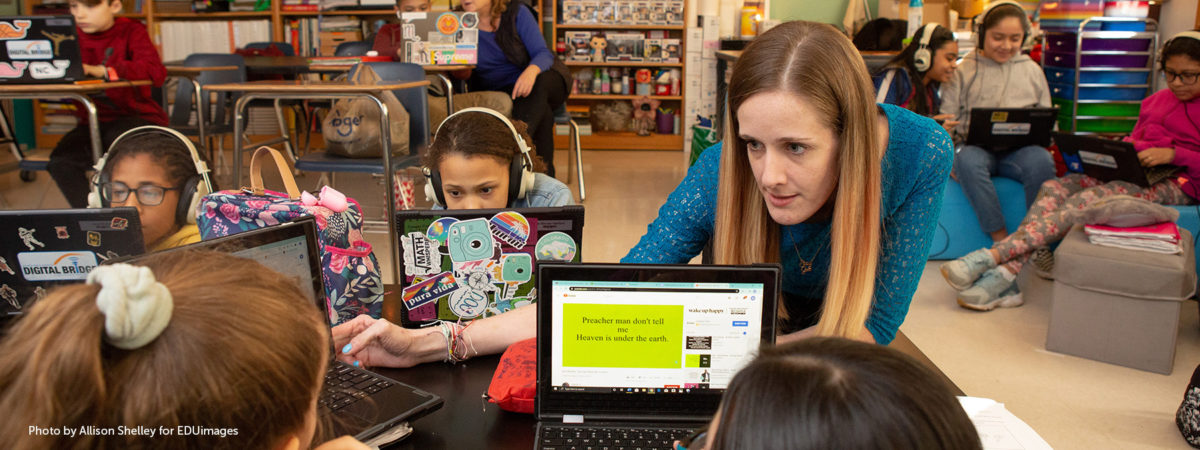An unfortunate reality in classrooms today is that edtech is often used in a way that siloes learning experiences. I felt this firsthand as a learner when I returned to graduate school full-time—an experience that became strictly virtual and tech-dependent due to the pandemic. I’d read an article, watch a video, or listen to a lecture and then find myself alone with my thoughts about what I had just learned. Like many of our students, I yearned for peer interaction to fully comprehend the information.
How can we as educators leverage edtech to ensure students have opportunities to discuss, reflect on, and iterate on their learning with each other? How can we use edtech to provide opportunities for learners to exercise metacognition (thinking about one’s thinking), which is key for making sense of content and understanding ourselves as learners?
Teachers today are inundated with large swaths of digital tools but are rarely supported with the professional learning needed to use them to their highest potential. As a result, edtech is used to teach foundational skills, often as independent work with headphones. Once that daily benchmark is met, students log off, (hopefully) wrap up their headphones, close their laptops, and move on to the next activity. This unfortunately results in little opportunity for students to reflect on their learning individually, with their peers, or with their teachers.
I’ve found these three activities to be valuable in un-siloing learning for my students:
- Discussions: Many of the edtech products used in classrooms provide easy-to-read, real-time data on various fluency skills. By using this data, I can identify trends and patterns to help me plan lessons and support students’ own understanding of their learning. Before sending students off to achieve daily benchmark/minutes, I briefly meet with them individually or in small groups to discuss their progress and provide gentle reminders of the objectives for their learning. A quick check-in and some evidence-based feedback can motivate students to use their edtech time productively and with specific goals in mind.
- Reflection Journals: I provide students with opportunities to use journals after edtech sessions to encourage students to reflect on their learning. As John Dewey said, “We do not learn from experience…We learn from reflecting on experience.” When students have the opportunity to freely reflect on their experiences or with quick teacher prompts, they gain additional opportunities to make sense of their learning. After they complete their daily benchmark, students can open their digital reflection journals (such as on a platform like Google Docs), and type their thoughts and feelings about that session. Many of these types of platforms have speech-to-text and/or capabilities for students to provide reflections in their native language, allowing all users to cohesively capture their responses. Additionally, these responses can be shared to spark future classroom discussions and ensure all students are included. If journaling is a practice that is used in various content areas, it can be shared with families to provide a snapshot of their child’s thinking and provide great insight to the question “What did you learn today?”
- Charting: I use the data and analytics from edtech to demonstrate the achievements of the class. Students can even plot it themselves when they are given their own data. This asset-based visual representation (e.g., a bar graph or visual that ties into thematic classroom or school culture) celebrates the hard work of the whole class. Like other classroom displays, this kind of data display chart is designed to stimulate conversation that authentically engages students in academic discourse and shows visitors the learning and progress being made in your room. In addition, I use this data display as a motivating factor for classroom celebrations based on progress toward shared goals. Since all of our students are at different places academically, we shouldn’t focus on charting mastery levels, but can instead focus on growth happening at any level.
As educators, we need to be cognizant of the role edtech has in our students’ social learning. By using data and edtech platforms, we can not only strengthen our lessons but also create positive social learning discussions for students to share their thinking and invite joy into their learning experiences. These opportunities allow students to make sense of content as learners while also allowing them to hear their peers’ perspectives, which supports metacognition skills. As edtech continues to have a significant role in how we teach and learn, we must continue to embrace it as a way not to just build and strengthen one academic skill set, but rather use it in meaningful ways to support the development of the whole child.
